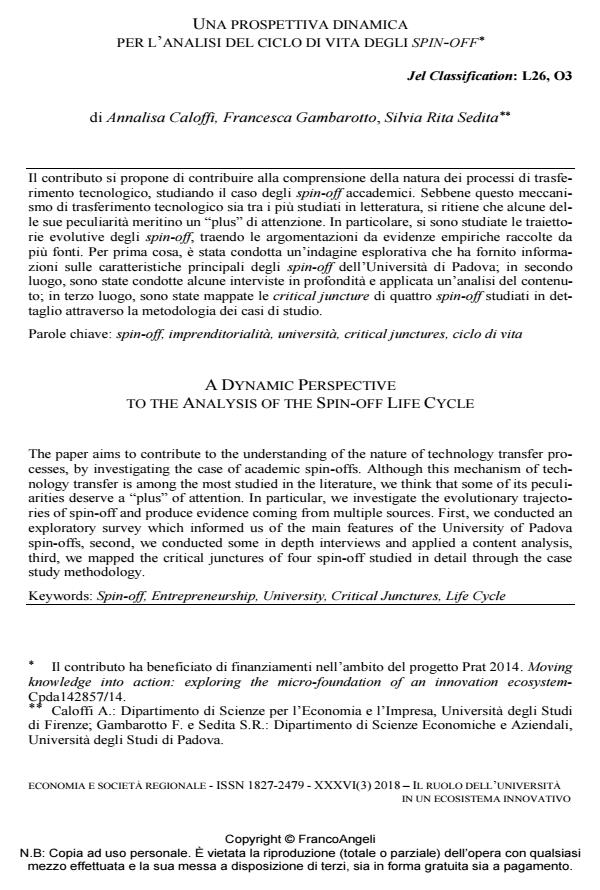A dynamic perspective to the analysis of the spin-off life cycle
Journal title ECONOMIA E SOCIETÀ REGIONALE
Author/s Annalisa Caloffi, Francesca Gambarotto, Silvia Rita Sedita
Publishing Year 2018 Issue 2018/3 Language Italian
Pages 9 P. 86-94 File size 223 KB
DOI 10.3280/ES2018-003008
DOI is like a bar code for intellectual property: to have more infomation
click here
Below, you can see the article first page
If you want to buy this article in PDF format, you can do it, following the instructions to buy download credits

FrancoAngeli is member of Publishers International Linking Association, Inc (PILA), a not-for-profit association which run the CrossRef service enabling links to and from online scholarly content.
The paper aims to contribute to the understanding of the nature of technology transfer processes, by investigating the case of academic spin-offs. Although this mechanism of technology transfer is among the most studied in the literature, we think that some of its peculiarities deserve a "plus" of attention. In particular, we investigate the evolutionary trajectories of spin-off and produce evidence coming from multiple sources. First, we conducted an exploratory survey which informed us of the main features of the University of Padova spin-offs, second, we conducted some in depth interviews and applied a content analysis, third, we mapped the critical junctures of four spin-off studied in detail through the case study methodology.
Keywords: Spin-off, Entrepreneurship, University, Critical Junctures, Life Cycle
Jel codes: L26, O3
- Di Gregorio D., Shane S. (2003). Why do some universities generate more start-ups than others? Research Policy, 32: 209-227.
- Laursen K., Salter A. (2006). Open for innovation: the role of openness in explaining innovation performance among UK manufacturing firms. Strategic Management Journal, 27(2): 131-150.
- Miller D., Friesen P.H. (1984). Organizations: A Quantum View. Englewood Cliffs (NJ): Prentice Hall.
- Pérez M., Martínez A.M. (2003). The development of University Spinoffs: early dynamics of technology transfer and networking. Technovation, 23: 823-831. DOI: 10.1016/S0166-4972(02)00034-2
- Smith K.G., Mitchell T.R., Summer C.E. (1985). Top-level management priorities in different stages of the organizational life-cycle. Academy of Management Journal, 28: 799-820.
- Stinchcombe A.L. (1965). Social structure and Organizations. In: March J.G., ed. Handbook of organizations. Chicago: Randy McNally and Company. Stokes D.E. (1997). Pasteur’s Quadrant-Basic Science and Technological Innovation. Washington DC: Brookings Institution Press.
- Van de Ven A.H., Hudson R., Schroeder D. (1984). Designing new business startups: entrepreneurial, organizational, and ecological considerations. Journal of Management, 10(1): 87-107.
- Van Geenhuizen M., Soetanto D.P. (2009). Academic spin-offs at different ages: A case study in search of key obstacles to growth. Technovation, 29: 671-681.
- Vohora A., Wright M., Lockett A. (2004). Critical junctures in the development of university high-tech spinout companies. Research Policy, 33(1): 147-175. DOI: 10.1016/S0048-7333(03)00107-0
- Chesbrough H. (2000). Designing corporate ventures in the shadow of private venture capital. California Management Review, 42(3): 31-49.
- Baba Y., Shichijo N., Sedita S.R. (2009). How do collaborations with universities affect firms’ innovative performance? The role of “Pasteur scientists” in the advanced materials field. Research Policy, 38(5): 756-764.
Annalisa Caloffi, Francesca Gambarotto, Silvia Rita Sedita, Una prospettiva dinamica per l’analisi del ciclo di vita degli spin-off in "ECONOMIA E SOCIETÀ REGIONALE " 3/2018, pp 86-94, DOI: 10.3280/ES2018-003008